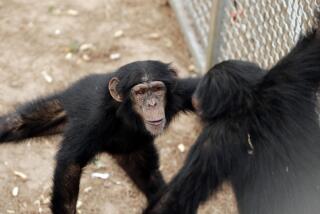Apes, like Proust, remember things past
- Share via
Great apes have a lot in common with Marcel Proust, it turns out. Their long-term memories can be provoked by the equivalent of dipping a madeleine in a cup of tea.
In this case, chimpanzees and orangutans remembered how to find tools that would help them get a banana or frozen yogurt, three years after being exposed to the task just four times, according to a study published Thursday in the review Current Biology. The apes also were able to remember a similar scenario from two weeks earlier, even though it was presented only once, the researchers found.
In both cases, the primates appeared to “bind” a set of cues together to form an autobiographical memory, a characteristic that was long thought to be uniquely human.
“I think what it tells us is our memory system is not as unique as we thought it was,” said Gema Martin-Ordas of Aarhus University in Denmark, lead author of the study.
For those who haven’t waded through “Remembrance of Things Past,” Proust dips a madeleine in tea and falls into a reverie over long-ago visits with his aunt Leonie. With an abundance of human self-consciousness, Proust could recount his memory. Chimps and orangutans aren’t so forthcoming.
“You can’t really ask a chimpanzee,” Martin-Ordas said. “The only thing we can do is accumulate pieces of evidence and see how close we can get to the idea of autobiographical memory or episodic memory without showing conscious recollection.”
To suss out whether apes had a remebrance of things past, researchers focused on “binding.” Could the chimpanzees and orangutans combine a set of cues, each of which may be associated individually with many events, to form a memory, and could they retrieve it based on those cues?
Martin-Ordas relied on our primate cousins’ ability to learn to use tools to retrieve out-of-reach rewards. The primates at the Germany’s Max Planck Institute, where Martin-Ordas had done her postdoctoral research, regularly do tasks involving tools.
Three years ago, Martin-Ordas hid two different sticks in separate slotted boxes and put banana pieces on platforms that were out of reach. Then she let the apes solve the problem. The chimps and orangutans then moved on to many other experiments over the years.
“They get a lot of experiments every day,” Martin-Ordas said.
Three years later, all but one of the 12 apes that had been exposed to the trick found the stick and got the fruit, within five seconds. Seven others that hadn’t been exposed didn’t find the tool by the end of a five-minute session.
Pini, an orangutan that, at 24 years old, is middle-aged, failed to reach the boxes. “She’s getting old,” Martin-Ordas said. “But she was successful in the second experiment.”
In the next trial, Pini and company saw Martin-Ordas hide a ball and they learned how to place it on a see-saw apparatus that would deliver frozen yogurt. Two weeks later, Martin-Ordas repeated the scenario, but left a part out.
“Instead of showing them the whole event, when they came into the room we only showed them the task,” Martin-Ordas siad. “And we used the task, and me, and the room, as the cues to see if we could trigger their memory.” Sure enough, Pini and 10 of her cohorts found the ball and got their yogurt. One chimp apparently forgot.
By splitting the animals into “exposed” and “naive” groups during both experiments, Martin-Ordas was able to figure out if the ones that were hip to the first experiment would see certain stimuli and guess to search for boxes or trays. They did neither.
“Even though they were walking around the rooms, they never searched for the tools,” she said. Finding the tools could not be explained by “just walking around,” she said. “It’s because they know; they remember the event in which the tools were hidden and they know where to look for them.”
The apes that succeeded in both experiments also appeared to know the difference between the sets of cues. “I think that’s stong evidence that they bind the elements of these different, but very similar, events and are able to distinguish between them,” Martin-Ordas said.
Martin-Ordas said she would like to experiment with the time period of these memories and delve into what apes may remember from infancy – a period of amnesia among humans.
Apes, she surmised, may share a human forgetfulness of things past.







